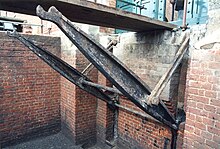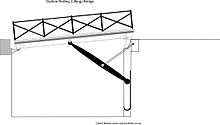96:
are pulled up onto the metal trays the weight of the lifting arms assists the raising of the bridge to a point where the centre of gravity of the arms is over the pivot of the upper support stays. From here on the pull necessary to raise the centre wheels is negligible. Once the lifting arms are in the fully retracted position the centre wheels are on top of the metal trays and the axles disengage from the cups. The bridge now sits on its inner two axles. From here it is necessary to pull the bridge in until the outer two wheels arrive at the trays. The bridge is then pulled within the gates on all six wheels.
499:
109:
subject was considered at a meeting of the
Ordnance Council held at War Office 9/ 7/69, and it was resolved to recommend the grant of 100l. to Mr. Guthrie. The Lords of the Treasury, 138/69, sanctioned the above, on the understanding that the invention had been carried out during unofficial hours. Mr. Guthrie, 13/9/69 stated that such was the case. A sum of 100l was inserted in the Army Estimates for 1870-71 as a reward to Mr. Guthrie; sanctioned by Parliament; and claim allowed, 27/07/70
32:
670:
88:
95:
To raise the bridge an initial lift to the inner end of the bridge is required. This raises the inner wheels back up the inclines of the granite slabs. At the same time the outer ends are pulled from the lip of the granite slab, the wheels rolling down the sprung metal guides. When the inner wheels
74:
When the bridge is just less than halfway out, the ends of the centre axle then engage in the cups of the lifting arms. The middle two wheels partially descend the slopes of the granite sill. The bridge continues to move out, its outer end dipping below the horizontal, its inner wheels still running
70:
Running the bridge out is effected by pushing it along its rails until the outer two wheels are at the edge of the granite sill of the ditch. When the bridge is pushed beyond this point the two outer wheels do not descend the slopes of the granite slabs but instead the bridge remains in a horizontal
78:
At a point where the inner wheels are at the top of the slope down the granite sill, the outer ends of the girders and the outer wheels hit curved sprung metal guides. These guide the outer end of the bridge upwards so that the ends of the girders come to rest on the lip of the granite slab, the
108:
Director of Works 18/08/69 submits a claim from Mr. Guthrie for some recognition of his services on account of his invention of a rolling bridge applicable to defensive works. Colonel
Jervois states that this bridge has been adopted with success in several of the forts recently constructed. The
75:
along the trays of the courtyard. The weight of the bridge, at the point where the centre of gravity of the lifting arms is beyond the pivot point of the arms and the stays, causes the bridge mechanism to descend, its wheels running up the vertical racers set into the wall of the pit.
136:
in Malta. The remains of another
Guthrie bridge was discovered at the main caponier of The Verne Citadel at Portland, Dorset, during research conducted by The Palmerston Forts Society and Hampshire County Council Architects for restoration work on the bridges at Fort Nelson.
71:
position. This is due to the centre axle being offset from the centre of the girders causing the bridge to run on its inner two wheels. The middle two wheels follow along the trays.
562:
58:
Rolling bridges were unhinged, and remained horizontal as they were retracted within the gates of a fortification, similar in operation to a modern
79:
inner wheels descending the slope of the inner granite slab. The inner end of each girder is angled to form a close fit with the granite slab.
598:
215:
608:
588:
530:
120:
Bridges of this type were fitted to the forts of the
Portsdown Hill line at Portsmouth. The lifting arms of both bridges survive at
593:
583:
246:
699:
310:
603:
197:
165:
Guthrie’s
Rolling Bridge by David Moore The Redan no. 26 October 1992: Journal of The Plamerston Forts Society
550:
540:
535:
449:
239:
557:
525:
51:. It was commonly installed as the access across the narrow steep sided ditches characteristic of the
694:
634:
618:
613:
578:
520:
121:
380:
325:
232:
212:
545:
487:
410:
8:
461:
295:
422:
405:
385:
375:
370:
146:
44:
17:
639:
498:
444:
330:
305:
285:
280:
193:
129:
673:
417:
515:
350:
219:
133:
104:
Director of
Artillery 8/8/70 forwards for record a correspondence, as follows:
655:
476:
466:
432:
365:
355:
315:
125:
52:
25:
21:
688:
456:
300:
59:
471:
395:
390:
192:
Fort Nelson and the
Portsdown Forts by Garry Mitchell: Solent Papers No.3
224:
427:
400:
345:
320:
275:
270:
31:
360:
340:
335:
290:
48:
437:
481:
87:
255:
128:. Other locations at which the bridge was installed include
91:
Beginning of lifting sequence of a
Guthrie Rolling Bridge
35:
Lifting arms of the
Guthrie Rolling Bridge at Fort Nelson
99:
563:List of lists of covered bridges in North America
686:
240:
174:Guthrie’s Rolling Bridge by David Moore ibid
254:
247:
233:
213:Victorian Forts data sheet on Fort Nelson
65:
86:
82:
30:
687:
228:
16:For the London "curling" bridge, see
13:
497:
100:The bridge adopted by the military
14:
711:
531:medieval stone bridges in Germany
206:
47:, an 18th-century version of the
669:
668:
20:. For an example of the rolling
186:
177:
168:
159:
1:
488:Visual index to various types
152:
311:Cantilever spar cable-stayed
115:
7:
140:
10:
716:
700:Bridges by structural type
15:
664:
648:
627:
571:
508:
495:
263:
183:National Archive WO33/2/A
599:Continuous truss bridges
572:Lists of bridges by size
509:Lists of bridges by type
122:Fort Nelson, Portsmouth
558:List of bridge–tunnels
502:
326:Double-beam drawbridge
111:
92:
66:Running the bridge out
41:Guthrie rolling bridge
36:
551:vertical-lift bridges
501:
106:
90:
83:Running the bridge in
34:
609:Masonry arch bridges
589:Cable-stayed bridges
536:multi-level bridges
594:Cantilever bridges
584:Suspension bridges
526:cantilever bridges
503:
423:Navigable aqueduct
218:2012-05-30 at the
93:
45:retractable bridge
37:
18:The Rolling Bridge
682:
681:
640:Bridge to nowhere
541:road–rail bridges
258:-related articles
130:Cambridge Battery
707:
695:Moveable bridges
672:
671:
628:Additional lists
264:Structural types
249:
242:
235:
226:
225:
200:
190:
184:
181:
175:
172:
166:
163:
147:Moveable bridges
715:
714:
710:
709:
708:
706:
705:
704:
685:
684:
683:
678:
660:
644:
635:Bridge failures
623:
567:
521:bascule bridges
516:List of bridges
504:
493:
381:Rolling bascule
259:
253:
220:Wayback Machine
209:
204:
203:
191:
187:
182:
178:
173:
169:
164:
160:
155:
143:
134:Rinella Battery
118:
102:
85:
68:
53:polygonal forts
43:was a kind of
29:
12:
11:
5:
713:
703:
702:
697:
680:
679:
677:
676:
665:
662:
661:
659:
658:
656:Bridges in art
652:
650:
646:
645:
643:
642:
637:
631:
629:
625:
624:
622:
621:
616:
611:
606:
601:
596:
591:
586:
581:
575:
573:
569:
568:
566:
565:
560:
555:
554:
553:
548:
543:
538:
533:
528:
523:
512:
510:
506:
505:
496:
494:
492:
491:
484:
479:
474:
469:
464:
459:
454:
453:
452:
442:
441:
440:
430:
425:
420:
415:
414:
413:
408:
403:
398:
393:
388:
383:
378:
373:
368:
363:
358:
348:
343:
338:
333:
328:
323:
318:
313:
308:
303:
298:
293:
288:
283:
278:
273:
267:
265:
261:
260:
252:
251:
244:
237:
229:
223:
222:
208:
207:External links
205:
202:
201:
185:
176:
167:
157:
156:
154:
151:
150:
149:
142:
139:
126:United Kingdom
117:
114:
101:
98:
84:
81:
67:
64:
26:Pegasus Bridge
22:bascule bridge
9:
6:
4:
3:
2:
712:
701:
698:
696:
693:
692:
690:
675:
667:
666:
663:
657:
654:
653:
651:
647:
641:
638:
636:
633:
632:
630:
626:
620:
617:
615:
612:
610:
607:
605:
602:
600:
597:
595:
592:
590:
587:
585:
582:
580:
577:
576:
574:
570:
564:
561:
559:
556:
552:
549:
547:
544:
542:
539:
537:
534:
532:
529:
527:
524:
522:
519:
518:
517:
514:
513:
511:
507:
500:
490:
489:
485:
483:
480:
478:
475:
473:
470:
468:
465:
463:
460:
458:
455:
451:
448:
447:
446:
443:
439:
436:
435:
434:
431:
429:
426:
424:
421:
419:
416:
412:
411:Vertical-lift
409:
407:
404:
402:
399:
397:
394:
392:
389:
387:
384:
382:
379:
377:
374:
372:
369:
367:
364:
362:
359:
357:
354:
353:
352:
349:
347:
344:
342:
339:
337:
334:
332:
329:
327:
324:
322:
319:
317:
314:
312:
309:
307:
304:
302:
299:
297:
294:
292:
289:
287:
286:Bridge–tunnel
284:
282:
279:
277:
274:
272:
269:
268:
266:
262:
257:
250:
245:
243:
238:
236:
231:
230:
227:
221:
217:
214:
211:
210:
199:
198:0-9513234-5-8
195:
189:
180:
171:
162:
158:
148:
145:
144:
138:
135:
131:
127:
123:
113:
110:
105:
97:
89:
80:
76:
72:
63:
61:
60:thrust bridge
56:
55:of this era.
54:
50:
46:
42:
33:
27:
23:
19:
604:Arch bridges
546:toll bridges
486:
462:Through arch
296:Cable-stayed
188:
179:
170:
161:
119:
112:
107:
103:
94:
77:
73:
69:
57:
40:
38:
406:Transporter
386:Submersible
371:Retractable
689:Categories
445:Suspension
361:Drawbridge
331:Extradosed
306:Cantilever
291:Burr Truss
281:Box girder
153:References
49:drawbridge
579:By length
418:Multi-way
116:Locations
674:Category
438:Vlotbrug
351:Moveable
216:Archived
141:See also
649:Related
619:Tallest
614:Highest
482:Viaduct
477:Tubular
467:Trestle
433:Pontoon
376:Rolling
366:Folding
356:Bascule
316:Covered
457:Timber
301:Canopy
256:Bridge
196:
24:, see
472:Truss
450:types
396:Table
391:Swing
428:Pile
401:Tilt
346:Moon
321:Crib
276:Beam
271:Arch
194:ISBN
132:and
341:Log
336:Jet
691::
124:,
62:.
39:A
248:e
241:t
234:v
28:.
Text is available under the Creative Commons Attribution-ShareAlike License. Additional terms may apply.

